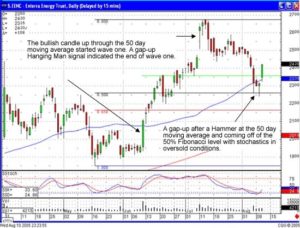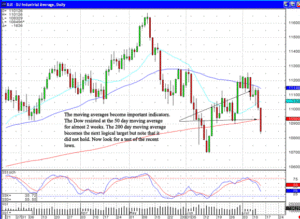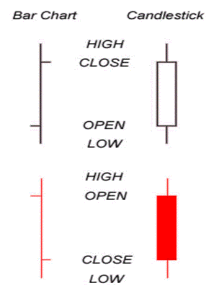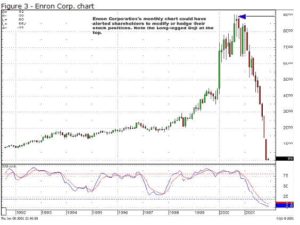When trading futures and options it is important to know the basics. Both deal with trading contracts and both rarely result in the actual delivery of a product. In today’s article we will discuss the futures market, the options market, as well as define options contracts and futures contracts.
The futures market is a market in which participants will buy and sell commodities and/or futures contracts. Futures trading requires a financial contract to obligate the buyer to purchase a particular asset and the seller to sell a particular asset at a predetermined date and price. Most of the time, there is no actual delivery of a physical product and the contracts are settled in cash. When studying futures and options it is important to understand what a futures contract is.
Futures contracts are contracts on stock market indexes, commodities or currencies. The purpose of the contracts is to attempt to predict the actual value of these financial securities at a date in the future. For example, when trading commodities, these futures contracts include a commitment by the seller to deliver a specific amount of the commodity during a specific month at a price that is determined by the futures market. Also when trading futures, the buyer has also agreed to buy that commodity during that month as well at the price determined by the future market. Most contracts are actually closed out before the delivery date and the trade never ends in actual delivery of the asset.
The options market is similar to the futures market in that an options contract is also an agreement between two parties to buy/sell an asset at a fixed price at a fixed date in the future. The difference however is that when options trading, as time passes, the buyer can let the options contract expire or opt not to fulfill it if the trade becomes unfavorable. When studying futures and options it is important that the investor understands that when someone buys an option, they pay the amount known as the premium to the seller. The premium is the actual cost of the option. The options trader in the United States trades options with a contract multiplier of 100. This is the number of shares per option traded and this contract multiplier allows even small investors to trade a large exposure, or leverage on a small amount of capital.
Continue to study options and futures to see if these markets are a good fit for you. There is a lot to learn and it can be tricky but if you take the time to learn, practice, and implement a strong options trading plan and trading strategies there is no reason why you cannot achieve success in the these markets. Good luck!
Market Direction
What do you expect from a professional money management advisor? Most people expect too much! It is anticipated that money managers will direct funds based upon some attention paid to market direction. Most money managers are very good at advising what should go into someone’s portfolio. Unfortunately most money managers do not know WHEN funds should be allocated. Do you have funds being managed? Are your parents funds being professionally managed? Your children’s funds? And are those portfolios down 35%, 45%, 55%, or greater over the past year? How often we are hearing about people’s retirement funds being cut in half.
The old philosophy of buying a well-run company and holding it long term is not a prudent strategy. It may have been 40 years ago, but the dynamics of the marketplace has changed dramatically. The world markets are now taking effect. Staid and conservative companies such as GM and Ford now have severe worldwide competition. One year ago, US steel Corp. was acclaimed as being a well-run, well positioned company, fundamentally very sound. If this stock had been put in your parents portfolio one year ago, it would have moved from approximately $190 per share to the current $18 a share. GE Corporation from $42 a share down to $7.00 a share. There are many examples of this type, this is not a surprise to anybody after watching the markets over the past 12 months. Tthe surprise should be realizing the number of money managers that thought it prudent to continue to hold positions through this severe market pullback.
If you are reading this commentary, it is assumed you have been looking to take more control of your own financial destiny. The Candlestick Forum provided recommendations for the past year that produced decent profits. Decent profits in the sense that a good percentage of the portfolio was allocated to short positions or the short funds. Did we short when the Dow was at 14,000 and continue to hold shorts all the way down? Definitely not, 2020 hindsight is always great. There were many zigzags as the market declined. The important fact remains that profits were made because short positions produced good profits, offsetting some of the long positions small lossesduring potential market turns. Overall, the accounts were profitable. This is a much different result than many investors witnessing their retirement accounts being decimated.
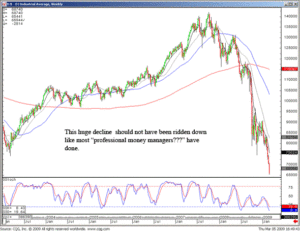
Dow Weekly Chart
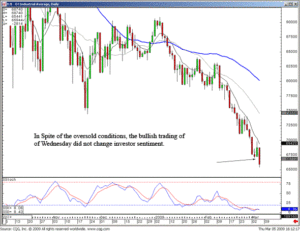
Dow
Professional money managers usually do not know how to time the markets. The serious investor should be learning how to use candlestick analysis effectively. It is not a difficult process to learn. Most important, with the information built into candlestick signals, a candlestick investor would have been able to exploit profits from the downward move of the market, not be caught with a portfolio that would have lost more than 50% of its value. How do you make money in a declining market? Join us tonight in the chat room 8 PM ET. We will discuss the signals and patterns that made good profits in the down trending market.
MDT, a recent short recommendation, has characteristics that make it a high probability high profit short trade. Candlestick analysis involves very simple visual analytical information conveyed by the formations. This allows the candlestick investor to know what investor sentiment is doing at critical support and resistance levels. This is merely common sense being enhanced by a powerful candlestick trading technique.
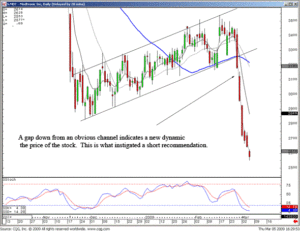
MDT
What is frustrating for most investors? Losing money in the markets and not being able to do anything about it. When you take control of your own investment education, you will now be able to command profits from the markets in uptrends as well as downtrends. You have to feel sorry for those people that have worked most of their lives and lost half of their retirement funds in the past 12 months. Don’t put yourself in that position.
Chat session tonight at 8 PM ET — everybody is welcome. Click here for instructions.
Good investing,
The Candlestick Forum Team
Big Profits Using Candlestick Signals and Gaps
Website special reflects current newsletter. If you are reading an archived newsletter you will be directed to Current Website Special.

